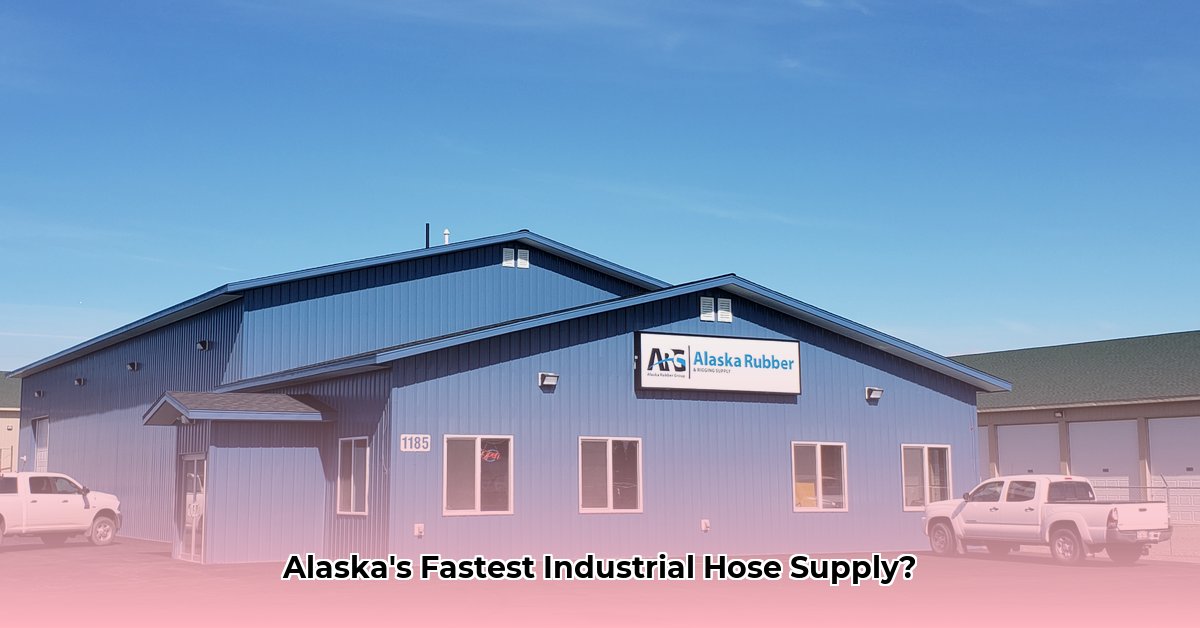
Finding the right industrial hose in Alaska's challenging environment is crucial for project success. The wrong choice can lead to costly delays and safety risks. This article examines Alaska Rubber Fairbanks (ARF), a key player in the Alaskan industrial hose market, highlighting its strengths, weaknesses, and potential for future growth. We'll explore how ARF helps businesses acquire the right hose swiftly and efficiently, focusing on its speed, expertise, and understanding of Alaska's unique industrial needs. Learn more about ARF at their website.
ARF's Winning Formula: Speed, Expertise, and Local Knowledge
ARF, part of the Alaska Rubber Group (ARG), distinguishes itself through rapid delivery and reliable service. Imagine this: your equipment is down, and you urgently need a specialized hose. ARF's extensive inventory and efficient logistics likely have the solution and can deliver it quickly, minimizing downtime and saving you valuable time and money. This is especially critical in Alaska's harsh climate and remote locations. Their team’s deep understanding of Alaskan industries and environmental conditions ensures they provide solutions tailored to the region's specific demands. How much does downtime cost your business annually? This rapid response directly mitigates those losses.
Current Market Position: A Strong Local Presence with Digital Room for Growth
While ARF enjoys a strong local reputation, its online presence needs strengthening. The current website lacks detailed product listings, pricing information, and customer testimonials – essential for attracting a wider customer base. It's like a hidden gem only accessible to those who already know about it. Expanding their digital footprint is key to unlocking further growth opportunities. Consider this: what percentage of your potential customers search online for industrial supplies? It's likely a very significant portion.
Charting a Course for Future Success: Strategic Initiatives for Growth
Despite ARF's inherent strengths, strategic initiatives can further propel its market position. Three pivotal areas for improvement include:
- Enhanced Digital Marketing: Targeted digital advertisements focused on specific Alaskan industries, showcasing successful projects, and engaging actively on relevant social media platforms could drastically increase brand awareness and customer acquisition. Imagine showcasing a case study: how ARF swiftly resolved a hose failure at a local mine, minimizing production downtime.
- Expanded Product Line: Offering a wider range of specialized hoses, such as those tailored for emerging renewable energy projects or designed to withstand extreme cold, would tap into new market segments and increase competitiveness.
- Optimized Operations: Investing in advanced inventory management and supply chain technology, including demand forecasting tools, would improve efficiency and minimize stockouts, ensuring consistent supply and operational reliability.
These strategic steps, combined with superior customer service, would lead to sustainable growth and solidify ARF's leading position in the Alaskan market.
Mitigating Risks: A Proactive Approach to Challenges
Like any business, ARF faces potential risks. However, proactive mitigation strategies are key to maintaining stability and long-term growth. Key considerations and potential solutions are outlined below:
| Risk Category | Likelihood | Impact | Mitigation Strategy |
|---|---|---|---|
| Supply Chain Disruptions | Moderate | High | Diversify suppliers; secure long-term contracts for essential materials; investigate alternative shipping routes |
| Increased Competition | Moderate | Moderate | Enhance brand awareness; focus on exceptional customer service; target unique niche markets |
| Technological Advancements | Low | High | Continuous monitoring of industry trends; strategic investment in advanced technologies; comprehensive employee training programs |
| Regulatory Compliance | Low | Moderate | Proactive adherence to all relevant safety and environmental regulations; collaboration with legal experts |
By proactively addressing these challenges, ARF can further strengthen its position.
Finding Specialized Industrial Hoses in Alaska: A Buyer's Guide
Alaska's unique industrial landscape presents specific challenges in sourcing specialized hoses. Understanding the market and choosing the right supplier is paramount. Here are some steps to assist in the procurement process:
- Define Your Needs: Clearly specify the hose type, required specifications, and volume requirements. This forms the foundation of your search for a suitable supplier.
- Conduct Online Research: Utilize the internet to locate potential suppliers, reviewing their websites for product catalogs, client testimonials, and service areas.
- Compare Multiple Suppliers: Contact multiple suppliers to compare their offerings, pricing, and delivery timelines. A broad comparison is vital for informed decision-making.
- Request Detailed Quotations: Obtain comprehensive quotes, including shipping costs and potential delays, ensuring transparency and clarity.
- Validate References and Reviews: Check online reviews and request client references for firsthand insights into the supplier's performance and reliability.
- Consider Location and Logistics: Choose a supplier with a strategic location to minimize shipping times and prevent weather-related delays.
- Assess Supply Chain Resilience: Inquire about the supplier's supply chain management practices, ensuring their preparedness to handle potential disruptions.
By following these steps and considering factors such as inventory management, technical expertise, customer service, and emergency response capabilities, businesses can confidently find the ideal industrial hose supplier in Alaska. ARF's strong local presence and rapid response capabilities make them a viable contender, but thorough due diligence is always advised.